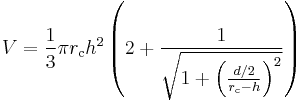Dome (mathematics)
In mathematics, a dome is a closed geometrical surface which can be obtained by sectioning off a portion of a sphere with an intersecting plane. It consists of two parts: (1) a flat disk, which is joined to (2) a convex surface whose curvature is uniform and which has a circular boundary: this boundary joins with the rim of the disk. The disk can be referred to as the dome's "base".
A pair of parameters are enough to describe a dome: (1) its diameter and (2) its height. The diameter refers to the size of the base, whereas the height refers to the perpendicular distance between the center of the base and the center of the concavity.
The dome's convex region, which may be referred to here as "ceiling" (in an analogy with architecture) has a radius of curvature rc given by
where d is the diameter and h is the height.
The kind of dome described so far is a spherical dome, though there are variants, such as the spheroidal dome, obtained by sectioning off a portion of a spheroid so that the resulting dome is symmetrical (having an axis of rotation), and likewise the ellipsoidal dome derived from the ellipsoid.
The surface area of a spherical dome's ceiling is
and the dome's volume is given by
where r=d/2.
See also
- Dome — general meaning
- Spherical cap




